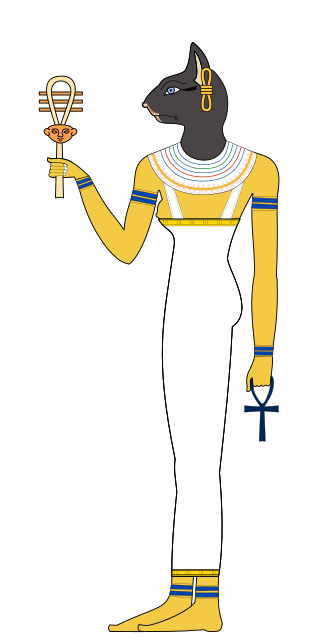
Bastet or Bast is a goddess of ancient Egyptian religion, worshipped as early as the Second Dynasty. Her name also is rendered as B'sst, Baast, Ubaste, and Baset. In ancient Greek religion, she was known as Ailuros.

Hathor was a major goddess in ancient Egyptian religion who played a wide variety of roles. As a sky deity, she was the mother or consort of the sky god Horus and the sun god Ra, both of whom were connected with kingship, and thus she was the symbolic mother of their earthly representatives, the pharaohs. She was one of several goddesses who acted as the Eye of Ra, Ra's feminine counterpart, and in this form she had a vengeful aspect that protected him from his enemies. Her beneficent side represented music, dance, joy, love, sexuality, and maternal care, and she acted as the consort of several male deities and the mother of their sons. These two aspects of the goddess exemplified the Egyptian conception of femininity. Hathor crossed boundaries between worlds, helping deceased souls in the transition to the afterlife.
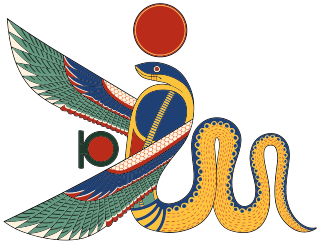
Wadjet, known to the Greek world as Uto or Buto among other renderings including Wedjat, Uadjet, and Udjo, was originally the ancient Egyptian local goddess of the city of Dep or Buto in Lower Egypt, which was an important site in prehistoric Egypt.
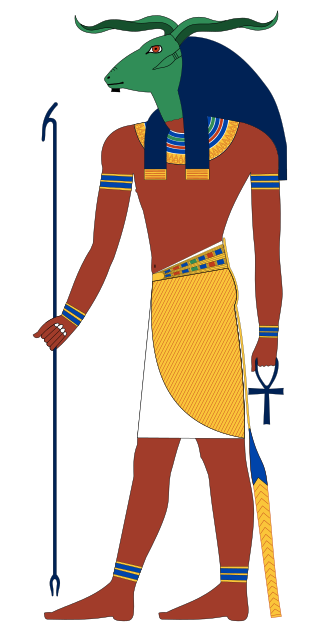
Khnum, also romanised Khnemu, was one of the earliest-known Egyptian deities, originally the god of the source of the Nile. Since the annual flooding of the Nile brought with it silt and clay, and its water brought life to its surroundings, he was thought to be the creator of the bodies of human children, which he made at a potter's wheel, from clay, and placed in their mothers' wombs. He was later described as having moulded the other deities, and he had the titles "Divine Potter" and "Lord of created things from himself".

Satet,Satit or Satjet, Satjit in Ancient Egyptian, Greek: Satis, also known by numerous related names, was an Upper Egyptian goddess who, along with Khnum and Anuket, formed part of the Elephantine Triad. A protective deity of Egypt's southern border with Nubia, she came to personify the former annual flooding of the Nile and to serve as a war, hunting, and fertility goddess.
Montu was a falcon-god of war in the ancient Egyptian religion, an embodiment of the conquering vitality of the pharaoh. He was particularly worshipped in Upper Egypt and in the district of Thebes.
[Ramesses II] whom victory was foretold as he came from the womb,
Whom valor was given while in the egg,
Bull firm of heart as he treads the arena,
Godly king going forth like Montu on victory day.

Mehet-Weret or Mehturt is an ancient Egyptian deity of the sky in ancient Egyptian religion. Her name means "Great Flood".

Meretseger was a Theban cobra-goddess in ancient Egyptian religion, in charge with guarding and protecting the vast Theban Necropolis — on the west bank of the Nile, in front of Thebes — and especially the heavily guarded Valley of the Kings. Her cult was typical of the New Kingdom of Egypt.

Abu Simbel is a historic site comprising two massive rock-cut temples in the village of Abu Simbel, Aswan Governorate, Upper Egypt, near the border with Sudan. It is located on the western bank of Lake Nasser, about 230 km (140 mi) southwest of Aswan. The twin temples were originally carved out of the mountainside in the 13th century BC, during the 19th Dynasty reign of the Pharaoh Ramesses II. Their huge external rock relief figures of Ramesses II have become iconic. His wife, Nefertari, and children can be seen in smaller figures by his feet. Sculptures inside the Great Temple commemorate Ramesses II's heroic leadership at the Battle of Kadesh.

Elephantine is an island on the Nile, forming part of the city of Aswan in Upper Egypt. The archaeological sites on the island became a World Heritage Site in 1979 along with other examples of Upper Egyptian architecture, as part of the "Monuments from Abu Simbel to Philae".
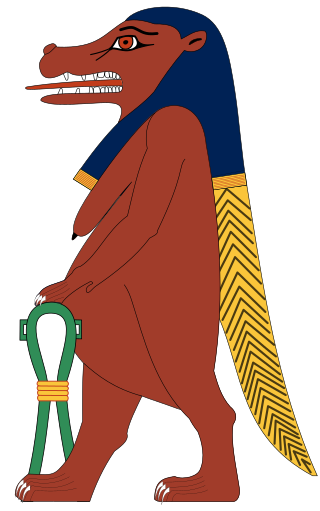
In Ancient Egyptian religion, Taweret is the protective ancient Egyptian goddess of childbirth and fertility. The name "Taweret" means "she who is great" or simply "great one", a common pacificatory address to dangerous deities. The deity is typically depicted as a bipedal female hippopotamus with feline attributes, pendulous female human breasts, the limbs and paws of a lion, and the back and tail of a Nile crocodile. She commonly bears the epithets "Lady of Heaven", "Mistress of the Horizon", "She Who Removes Water", "Mistress of Pure Water", and "Lady of the Birth House".

The Eye of Ra or Eye of Re, usually depicted as sun disk or right wedjat-eye, is an entity in ancient Egyptian mythology that functions as an extension of the sun god Ra's power, equated with the disk of the sun, but it often behaves as an independent goddess, a feminine counterpart to Ra and a violent force that subdues his enemies. This goddess, also known with the theonym Wedjat, can be equated with several particular deities, including Hathor, Sekhmet, Bastet, Raet-Tawy, and Mut. The eye goddess acts as mother, sibling, consort, and daughter of the sun god. She is his partner in the creative cycle in which he begets the renewed form of himself that is born at dawn. The eye's violent aspect defends Ra against the agents of disorder that threaten his rule. This dangerous aspect of the eye goddess is often represented by a lioness or by the uraeus, or cobra, a symbol of protection and royal authority. The disastrous fury and rampages of the eye goddess and the efforts of the gods to appease her are a prominent motif in Egyptian mythology.
Sehel Island is located in the Nile, about 2 miles (3.2 km) southwest of Aswan in southern Egypt. It is a large island, and is roughly halfway between the city and the upstream Aswan Low Dam.

The Famine Stela is an inscription written in Egyptian hieroglyphs located on Sehel Island in the Nile near Aswan in Egypt, which tells of a seven-year period of drought and famine during the reign of pharaoh Djoser of the Third Dynasty. It is thought that the stele was inscribed during the Ptolemaic Kingdom, which ruled from 332 to 31 BC.

The National Museum of Sudan or Sudan National Museum, abbreviated SNM, is a two-story building, constructed in 1955 and established as national museum in 1971.
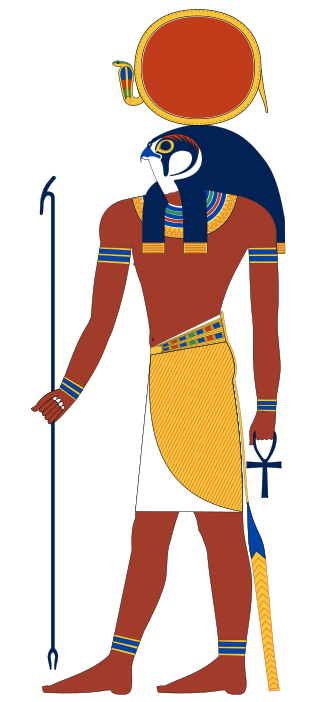
Ra or Re was the ancient Egyptian deity of the Sun. By the Fifth Dynasty, in the 25th and 24th centuries BC, he had become one of the most important gods in ancient Egyptian religion, identified primarily with the noon-day sun. Ra ruled in all parts of the created world: the sky, the Earth, and the underworld. He was believed to have ruled as the first pharaoh of Ancient Egypt. He was the god of the sun, order, kings and the sky.

The Temple of Beit el-Wali is a rock-cut ancient Egyptian temple in Nubia which was built by Pharaoh Ramesses II and dedicated to the deities of Amun-Re, Re-Horakhti, Khnum and Anuket. It was the first in a series of temples built by Ramesses II in this region; its name Beit el-Wali means 'House of the Holy Man' and may indicate its previous use by a Christian hermit at some point in time. The temple was relocated during the 1960s as part of the International Campaign to Save the Monuments of Nubia as a result of the Aswan High Dam project and moved towards higher ground along with the Temple of Kalabsha. This move was coordinated with a team of Polish archaeologists financed jointly by a Swiss and Chicago Institute respectively. The temple was located 50 kilometres south of Aswan.

Heqet, sometimes spelled Heket, is an Egyptian goddess of fertility, identified with Hathor, represented in the form of a frog. To the Egyptians, the frog was an ancient symbol of fertility, related to the annual flooding of the Nile. Heqet was originally the female counterpart of Khnum, or the wife of Khnum by whom she became the mother of Her-ur. It has been proposed that her name is the origin of the name of Hecate, the Greek goddess of witchcraft.

Ta-Seti was the first nome of Upper Egypt, one of 42 nomoi in Ancient Egypt. Ta-Seti marked the border area towards Nubia, and the name was also used to refer to Nubia itself.
The Temple of Satet or Satis was an ancient Egyptian temple dedicated to the goddess Satet, a personification of the Nile inundation. The temple was located on the Nile Valley island of Elephantine, Egypt. Founded during the late Predynastic Period around 3200 BC, it was enlarged and renovated several times from the Early Dynastic Period onwards over the next 3000 years until the Ptolemaic Period. The temple of Satet is the best example of an ancient Egyptian temple whose construction is attested over the entire pharaonic period.





















